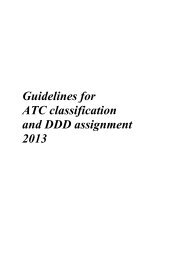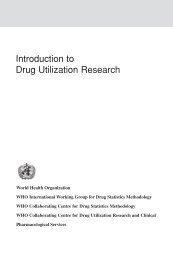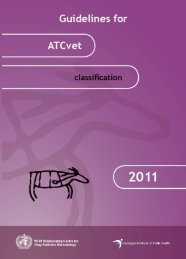Guidelines for ATC classification and DDD assignment - WHOCC
Guidelines for ATC classification and DDD assignment - WHOCC
Guidelines for ATC classification and DDD assignment - WHOCC
Create successful ePaper yourself
Turn your PDF publications into a flip-book with our unique Google optimized e-Paper software.
Use of the <strong>ATC</strong>/<strong>DDD</strong> system allows st<strong>and</strong>ardisation of drug groupings <strong>and</strong> a stable<br />
drug utilization metric to enable comparisons of drug use between countries,<br />
regions, <strong>and</strong> other health care settings, <strong>and</strong> to examine trends in drug use over time<br />
<strong>and</strong> in different settings.<br />
Drug consumption figures should preferably be presented as numbers of<br />
<strong>DDD</strong>s/1000 inhabitants/day or, when in-hospital drug use is considered, as <strong>DDD</strong>s<br />
per 100 bed days. Sales or prescription data presented in <strong>DDD</strong>/1000<br />
inhabitants/day may provide a rough estimate of the proportion of the population<br />
within a defined area treated daily with certain drugs. For example, the figure 10<br />
<strong>DDD</strong>s/1000 inhabitants/day indicates that 1% of the population on average gets a<br />
certain treatment daily.<br />
For antiinfectives (or other drugs normally used in short periods) it is often<br />
considered most appropriate to present the figures as numbers of <strong>DDD</strong>s per<br />
inhabitant per year, which will give an estimate of the number of days <strong>for</strong> which<br />
each inhabitant is, on average, treated annually.<br />
For example, 5 <strong>DDD</strong>s/inhabitant/year indicates that the consumption is equivalent<br />
to the treatment of every inhabitant with a 5 days course during a certain year.<br />
Alternatively, if the st<strong>and</strong>ard treatment period is known, the total number of <strong>DDD</strong>s<br />
can be calculated as the number of treatment courses, <strong>and</strong> the number of treatment<br />
courses can then be related to the total population.<br />
For some drug groups where <strong>DDD</strong>s have not been established, alternative ways of<br />
presenting data are recommended. For example, consumption of dermatological<br />
preparations can be presented in grams of ointment, cream etc, <strong>and</strong> antineoplastic<br />
agents <strong>ATC</strong> group L01 can be presented in grams of active ingredient.<br />
When there is a known discrepancy between the prescribed daily dose (PDD) <strong>and</strong><br />
the <strong>DDD</strong>, it is important to take this into account when interpreting drug<br />
consumption figures. Caution should also be taken in situations where the<br />
recommended dosage differs from one indication to another (e.g. antipsychotics), in<br />
severe versus mild disease (e.g. antibiotics) <strong>and</strong> where PDDs may differ from one<br />
population to another (e.g., according to sex, age, ethnicity or geographic location).<br />
Finally, it should be taken into considerations that some prescribed medications are<br />
not dispensed, <strong>and</strong> the patient does not always take all the medications, which are<br />
dispensed. Specially designed studies are required to measure actual drug intake at<br />
the patient level.<br />
34





